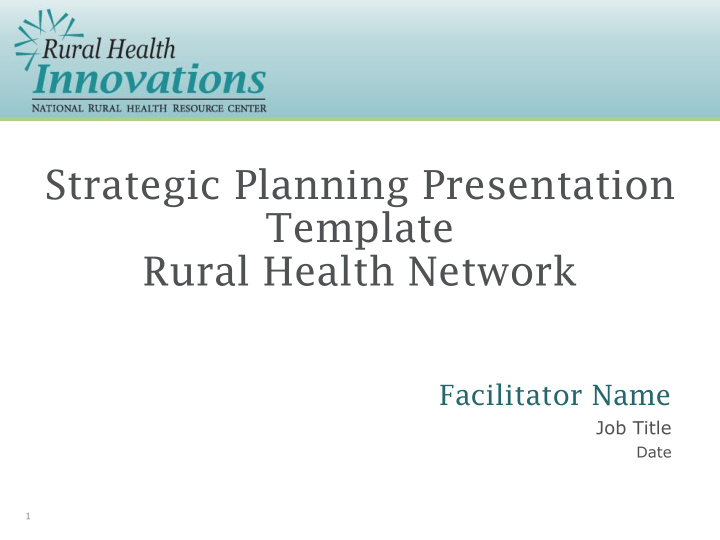



Strategic Planning Presentation Template Rural Health Network Facilitator Name Job Title Date 1
Strategic Planning “ It is not enough to just do your best or work hard. You must know what to work on.” – Edward Deming 2
A Collaborative Effort 3
Agenda Morning: 8:30 a.m. – 12:30 p.m. Strategic Planning – Part I Environmental Data • Levers and Blocks Analysis • Vision Discussion • Afternoon 1:00 – 4:00 p.m. Strategic Planning – Part II Strategic Objectives Workshop • Alignment with Mission, Vision and Studer • 4
Working Together Ground Rules 5
Why do Strategic Planning? The best way to predict your future is to create it. -Peter F. Drucker 6
Planning Methodology 7
Network Mission [insert Network’s mission] 8
Network Values [insert Network’s values] 9
Aiming for the Vision Adapted “Creative Tension” model by Peter Senge, et. al. 10
Network Vision Check-In and Commitment [insert Network’s vision] 11
Strategic Cycle: Begin with Analyze and Plan 12
What is the Value of Strategy? 13
Analyze and Phase Plan Consider the environmental factors and look for: • Symptoms of change • Root causes of change 14
National Health Care Update • Better care • Better health • Lower cost 15
What is happening in our region or state? • Consider participation in an ACO, a medical home or other value-based models • Partner with local primary care physicians • Care coordination initiatives • Prepare for population health management 16
‘State of the Network’ Report [insert and present findings or progress updates] 17
Network Members [insert and present members’ names] 18
Network Governance [insert governance highlights to be presented by Network Director] 19
Current Network Services and Value [insert and present current listing services] 20
Network Financial Update [insert highlights of finances to be presented by the Network Director] 21
Network Program and Initiative Update [insert and present programs and initiative update by the Network Director] 22
Network Environmental Data: Demographics [present environmental data – secondary data analysis such as demographic income, education, population (aging) ] 23
Network Environmental Data: Health Factors [insert and present environmental data – secondary data analysis such as behavioral health factors, public health issues, and community health profile by county ] 24
Network Member Input: Network Strength/Gap [key informant or interview data of members and partners and community members can be very helpful for gathering insights on the networks’ strengths and gaps as an organization; insert key informant interview summaries and focus groups by describing methodology and providing summary results ] 25
Network Member Input: Member Needs and Network Opportunity [key informant or interview data of members and partners and community members can be very helpful for gathering insights on the networks’ strengths and gaps as an organization; insert key informant interview summaries and focus groups by describing methodology and providing summary results] 26
What to work on? “It is not enough to just do your best or work hard. You must know what to work on.” -Edward Deming 27
What’s Next for Planning? • Levers and Blocks Workshop: looking at the log jam from the top of the tree • Strategic Objectives Workshop: together finding the paths that will move us toward our vision 28
BREAK 29
Contact Information Facilitator's Full Name Title Phone Number Email Get to know us better: http://www.ruralcenter.org 30
Recommend
More recommend